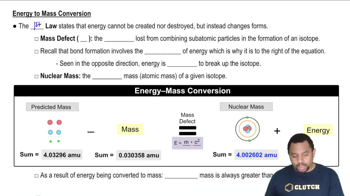Here are the essential concepts you must grasp in order to answer the question correctly.
Nuclear Fusion
Nuclear fusion is the process by which two light atomic nuclei combine to form a heavier nucleus, releasing energy in the process. In stars, hydrogen nuclei (protons) fuse to form helium, specifically an alpha particle, which is a helium-4 nucleus. This reaction is fundamental to stellar energy production and is responsible for the immense energy output of stars.
Recommended video:
Mass-Energy Equivalence
Mass-energy equivalence, encapsulated in Einstein's equation E=mc², states that mass can be converted into energy and vice versa. In the context of nuclear fusion, the mass of the resulting helium nucleus is less than the total mass of the original hydrogen nuclei. This 'missing' mass is converted into energy, which can be calculated to determine the energy released during the fusion process.
Recommended video:
Energy to Mass Conversion
Binding Energy
Binding energy is the energy required to disassemble a nucleus into its constituent protons and neutrons. It is also the energy released when a nucleus is formed from these particles. In fusion reactions, the binding energy per nucleon increases as lighter nuclei combine to form a heavier nucleus, resulting in a net release of energy, which is a key factor in understanding the energy output of stars.
Recommended video:
 Verified step by step guidance
Verified step by step guidance

